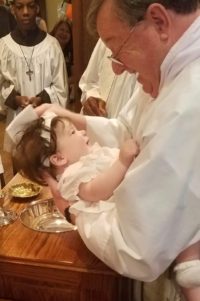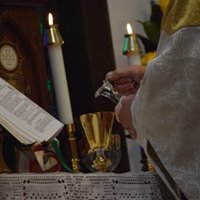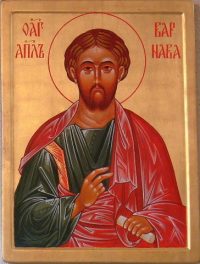Sacramental Life

THE SACRAMENTAL LIFE:
Sacramental symbols draw on our salvation history and reflect the role of the Church as a Sacrament of God’s presence in the world. God performs the Sacraments with ministers as God’s human agents. Sacrament comes from a Latin word (sacrare) meaning holy. Anglican definition of a Sacrament is:
“The outward and visible sign of an inward and spiritual grace given unto us; ordained by Christ himself (Book of Common Prayer page 292 … as a means whereby we receive this grace, and a pledge to assure us thereof.”
The Sacraments of Baptism and The Holy Eucharist are grounded in scripture and essential for all Christians. Holy Matrimony, ordination, penance, and unction are called sacramental rites and are not essential for all Christians, but impart strengthening of grace for specific situations in life.
The actions of the Sacraments confer grace to live sacra-mentally in the world. Five things are required for a sacrament to be recognized or valid:
The Matter is the outward and visible sign of the sacrament.
The Form is the action required to perform the sacrament (basically the prayers and ritual used.)
The Intention is the result desired – the inward and spiritual grace of the sacrament.
The Subject is the person (persons) who is (are) to receive the sacrament.
The Minister is the person who is to celebrate or administer the sacrament.
Some sacraments may be celebrated only by a bishop, others by priest, and still others by any baptized Christian.
Baptism (1928 Book of Common Prayer Page 273:)
The Matter is water and the Form is three fold name and pouring or water or immersion. The intention is to give remission of sins and a new life, the subject is anyone not baptized, and the minister can be any Christian. Infants become living members into Christ’s Holy Church (His family) through Baptism. Parents and godparents (for males: two Godfathers and one Godmother and for females: two Godmothers and one Godfather) make the baptismal promises on behalf of the child being baptized and promises made to support the child’s growth in faith. Baptism is performed only once for an individual. We live our Baptism by fulfilling the promises made.
Confirmation (Book of Common Prayer page 296:)
The Matter is the laying on Bishop’s hands and the Form is receiving the gift of the Holy Ghost (Father, Son and Holy Ghost.) The intention is to give the “gift” of the Holy Ghost for lay ministry, the Subject is any baptized Christian. Confirmation completes the baptism and conveys the sevenfold gift of the Holy Spirit (Wisdom, Understanding, Counsel, Ghostly Strength, Knowledge, Godliness, Holy Fear). Confirmation implies a full knowledge of the importance of the Eucharist and the essentials of the Christian Faith. A person confirmed by a bishop within the Apostolic Succession from another branch of the Catholic Church is received into the Anglican Faith by our Bishop.
The Eucharist:
Is the regular duty of all Christians to receive frequently and was instituted at the Last Supper with His command to “This do as oft as ye shall eat/drink this in remembrance of me (I Cor 11:23-16.) The Matter is bread and wine and the Form are the words of the consecration together with the rest of the prayer. The Intention is to do what Christ did (and command us to do) at the Last Supper. The Subject is any baptized informed and confirmed Christian with the minister being a Bishop or Priest. The Holy Eucharist signifies the Body and Blood of Christ (The Real Presence), truly present in a way that we cannot explain. For Anglicans, the Holy Eucharist is not simply a memorial but a spiritual reliving of the one sacrifice of Christ on the cross. It is the spiritual food of the most precious Body and Blood of our Saviour, Jesus Christ, and includes us as members of the mystical Body of Christ (past, present, and to come.) Through the Holy Eucharist, the Church is unified with Christ and becomes a sign to the world of Christ’s redeeming sacrifice.
The rite of the Holy Eucharist is a rehearsal for judgement day, and a vivid presentation of the entire history of salvation: the Mass recaptures for us and liturgically expresses the drama and economy of redemption in the beginning as Original Sin occurred when man disobeyed God by transgressing His will; so too now, we are personally and corporately guilty of disobeying God and transgressing His Commandments – and therefore we acknowledge at the beginning of the Liturgy that we have all sinned and fallen short of the glory of God, pleading for God’s mercy and forgiveness, and for His grace to live holier and better lives. We have been given the Law of God, and we have not kept it – our confession of this fact at the beginning of the Mass places us in the right spiritual disposition to worship the Blessed Trinity and to receive the gift of the Blessed Sacrament, the true Body and Blood of Christ, for the forgiveness of sins and eternal life. At the outset, we admit our sins and failings, recognizing with Saint Paul that the Law of God is a ‘schoolmaster that brings us to Christ so that we may be justified by faith’ (Galatians 3.24). The Law shows us that we are all sinners in need of a Saviour and Redeemer. The Law cannot of itself save – its purpose is to reveal to us our sinful nature and demonstrate that we must receive remission of sins from Jesus Christ as grace and gift. Only through Christ’s Atonement and only by our incorporation into Christ’s Body can we love and obey God in Christ by the power of His Spirit. The Ten Commandments instantly point us to Christ – and thus we say ‘Lord, have mercy upon us.’ The whole Liturgy of the Eucharist sacramentally applies the Person and Work of Jesus Christ to us.
Holy Orders: The sacrament of the ministry or ordination.
By the reading of Holy Scriptures and ancient Authors from the Apostles’ time there have been Orders of Ministers in Christ’s Church. Which offices were evermore had in such reverend estimation, that no man might presume to execute any of them, except he was first called, tried, examined and known to have such qualities as are requisite for the same.
The Matter is the Bishop’s hand and the Form is Receiving the gift of the Holy Ghost. The intention is to set a man apart for the work of the ordained ministry. The Subject is any baptized and confirmed male Christian and the Minister is a Bishop. Ordination may be done only once because it applies a change of character of the Subject through the action of the Holy Spirit.
Holy Matrimony:
Utilizes the Matter of a Handclasp and its Form is of The Promise. The Intention is to be a faithful spouse. The Subjects are the baptized Christian Man and Woman and the Minister are the marrying couple. Matrimony is a permanent body between the couple and represents the relationship between Christ and His Church; meaning that the husband is supposed to act toward his wife as Jesus acts towards the Church, and the wife behaving toward her husband as the Church acts towards Christ. This relationship allows for happiness and fulfillment together.
Penance: (confession)
The Matter the penance itself and the Form “I absolve thee in the Name of.” The Intention is to declare forgiveness of sin. The Subject is any Baptized Christian and the Minister is Bishop or Priest. The penance assigned is in relationship with the sin; ranging from prayers for help in personal improvement to making restitution (even turning oneself in to the authorities for a felony.) The confessor must never divulge a confession to a third party and cannot bring it up again to the Penitent unless brought up by the penitent under the seal of another confession.
Unction:
The Matter is Oil Blessed by the Bishop in the Form of “I anoint thee in the name of.” The Intention is to give health of body and of spirit. The Subject may be any baptized Christian and the Minister is a Bishop or Priest. There is none other Name under heaven given to man, in whom, and through whom, thou mayest receive health and salvation, but only the Name of our Lord Jesus Christ (BCP page 314.)
| Sacrament | Matter | Form | Intention | Subject | Minister |
| Baptism | Water | 3-fold name & pouring of water or immersion | To give remission os fins and new life | Anyone not already baptized | Any Christian |
| Confirmation | Bishop’s hand | Receive the gift of the Holy Ghost |
To give the gift of the Holy Ghost for lay ministry | Any Baptized Christian | Bishop |
| Order | Bishop’s hand | Receive the gift of the Holy Ghost |
To set a man apart for the work of the ordained ministry | Any Baptized and Confirmed male Christian | Bishop |
| Eucharist | Bread and wine |
The words of consecration together with the rest of the prayer | To do what Christ did at the Last Supper | Any baptized, informed and confirmed Christian | Bishop or Priest |
| Matrimony | Handclasp | The Promise | To be faithful to one spouse | Any baptized Christian man and woman | The Marrying couple |
| Penance | The Penance |
I absolve thee in the Name of … | To declare the forgiveness of sin | Any baptized Christian | Bishop or Priest |
| Unction | Oil blessed by bishop | I anoint thee in the name of … |
To give health of body and soul | Any baptized Christian | Bishop or Priest |
The “grace” is signified by the outward symbol. Taking Holy Baptism as an example, God uses the outward sign of water to confer the inward grace of new birth in Christ and forgiveness of sin.



![How did the early Christians worship? Let’s us read of early church worship. The First Apology (St. Justin Martyr) [a.d. 110-165.]](https://www.stmichaelsanglican.org/wp-content/uploads/2018/04/church-history1-e1562081769989.jpg)
